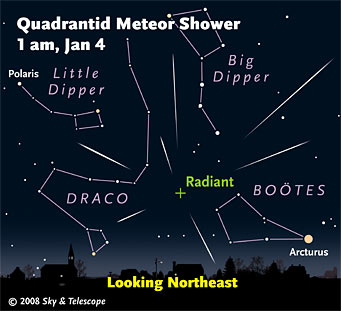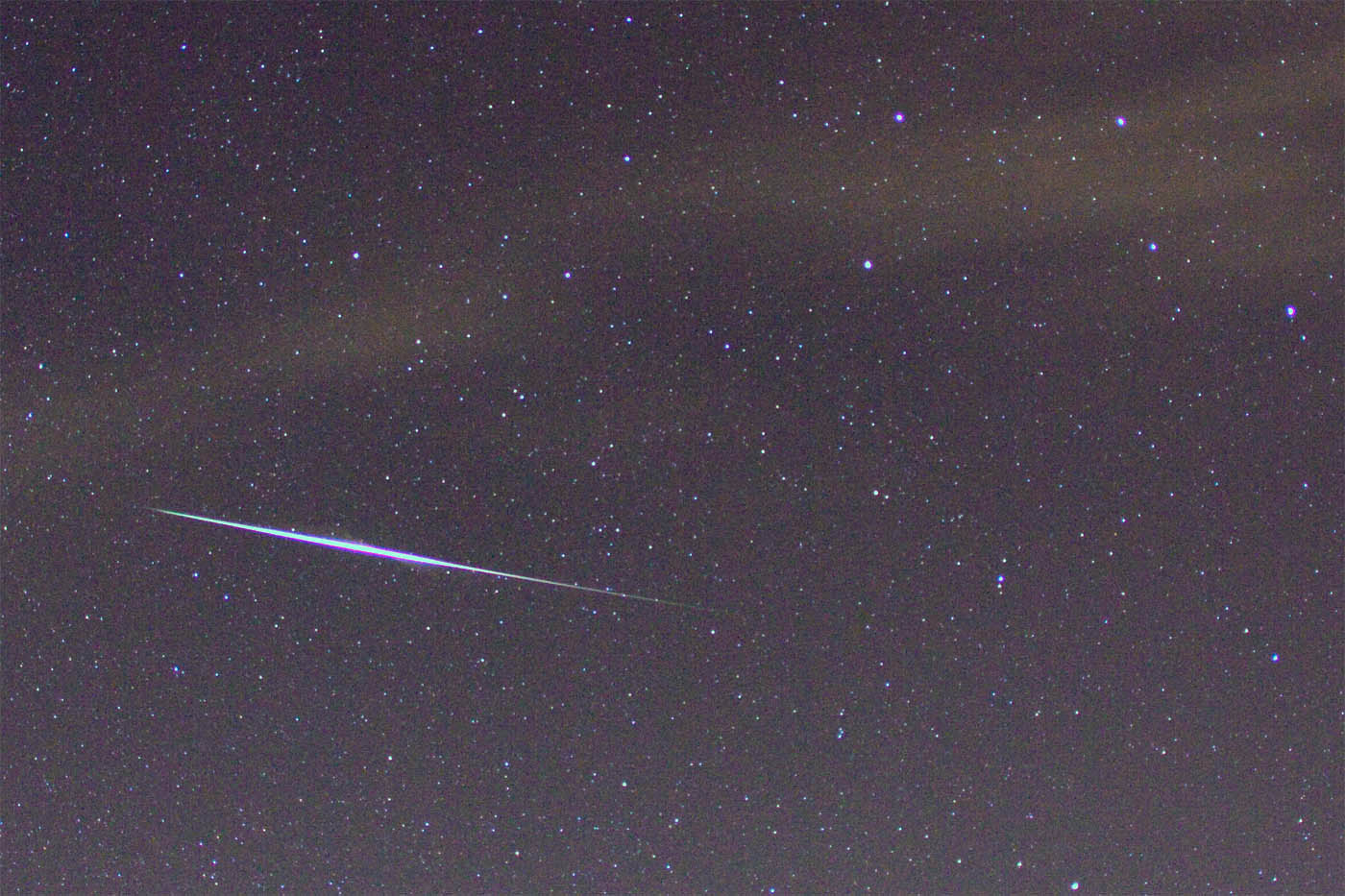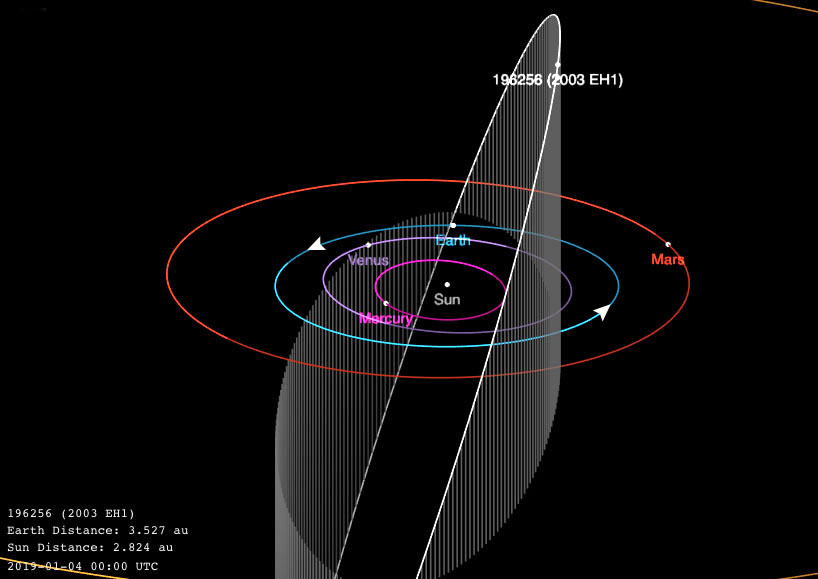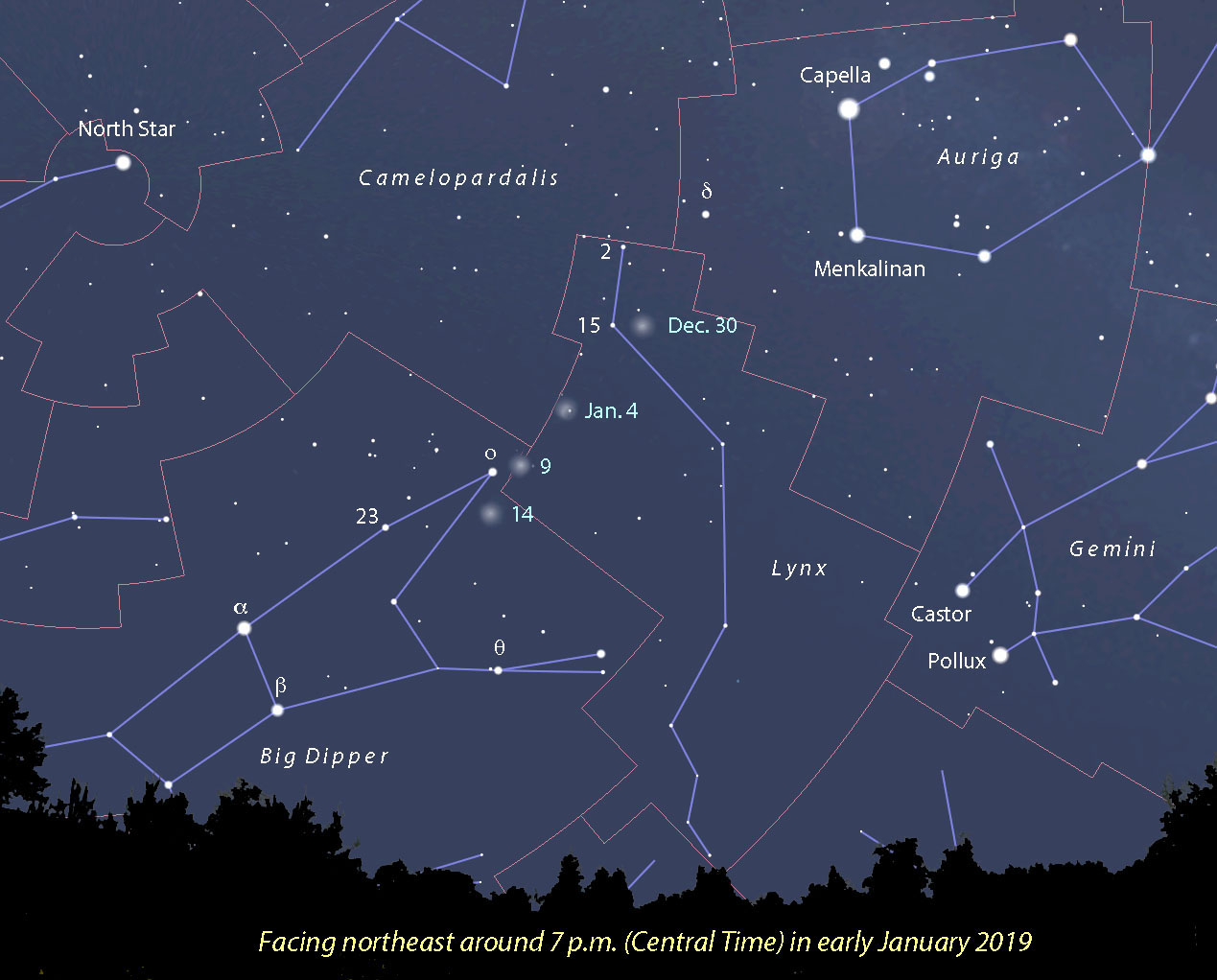Set aside your qualms about the cold and cash in on the Quadrantids, one of this year's best meteor showers.

Let's make it two in a row! Conditions were excellent for last month's Geminid meteor shower and will be again for the upcoming Quadrantids. This annual shower is something of a black sheep among meteor watchers with its brief peak, frigid viewing conditions, and odd origin. While active from late December to mid-January, most of the the shower's material is concentrated in a thin band which Earth passes through perpendicularly, the reason for its short duration. We're in and out in a little more than 6 hours.
But if maximum happens when the radiant stands high for your location, get ready for excitement. Sightings of 100 "Quads" an hour aren't uncommon, a not too rare prize. I've only seen one maximum, back in the 1980s. It was a bitter cold morning, but meteors popped out all over, making it one of the best showers I've ever seen.

According to Robert Lunsford of the American Meteor Society the 2019 peak will occur around 2:30 UT on Friday, January 4th, ideal for skywatchers in Europe, North Africa, and far western Asia. For other parts of the world, we can expect about 25 meteors per hour, still a good showing. No Moon will damage the meteoric goods as it's a super-thin crescent that won't show up till dawn. Speaking of which, if you get up before dawn to take in the meteor shower, stick around. You might just get to see the 672-hour-old Moon (1.5 days before new) 45 minutes before sunrise about 5° high in the southeastern sky, 15° to the lower left of Jupiter. If your eastern horizon allows, look for –0.4-magnitude Mercury glimmering about 2½° below the Moon. Bring binoculars for assistance.
The Quadrantids are a Northern-Hemisphere-only experience, as the radiant lies below the handle of the Big Dipper in Boötes at declination +49°. Northward of +40.5° latitude, the radiant is circumpolar, so it never actually dips below the horizon. As the stars pivot about Polaris, the radiant scrapes along the northern horizon for hours. While a low radiant will absolutely reduce meteor sightings, it may also afford us the opportunity to see at least a little of the shower at its peak across North America.

Bob King
2:30 UT translates to 9:30 p.m. Eastern Standard Time (8:30 Central; 7:30 Mountain, and 6:30 Pacific). If nothing else, skywatchers on Thursday evening (January 3rd) can watch for Quadrantid Earthgrazers by facing the northern sky during the evening hours. Earthgrazers are slow-moving meteors that launch upward from the horizon and flare for a long time before fading out. If you live in the wilds of northern Canada, north of about latitude 60° north, the radiant will stand at least 20° high in the northern sky even at nadir, making it easy to catch the peak that evening.
For those outside the narrow peak zone, you can observe the shower in stages, checking for Earthgrazers during the evening and then rising an hour or two before the start of dawn — between 4 to 6 a.m. local time — when the radiant stands highest in the northeastern sky. As always, there's no preferred direction in which to look, but avoid staring at the radiant, where meteors approach head on and sketch only short streaks. Facing about 90° away from the radiant provides a mix of short and longer, more dramatic trails.

NASA / JPL Horizons
Most meteor showers originate from comets, and it appears that the Quadrantids do, too. Meteor expert Peter Jenniskens found an excellent match between the ~2.9 kilometer-wide object 2003 EH1 and the meteor stream. While it's likely an "extinct" comet because it doesn't exhibit a fuzzy coma, the shower may have been spawned by the break-up of a larger comet into smaller pieces in the not-too-distant past, one of which became 2003 EH1.

Stellarium with additions by the author
I mentioned bringing binoculars for the Moon and Mercury, but you can also use them to observe our comet friend 46P/Wirtanen, now crossing from Lynx into Ursa Major. Last month, it was an easy naked-eye object from reasonably dark skies, but it's fading now as its distance from Earth continues to increase. On December 28th, I saw it only marginally without optical aid from a dark site at ~4.8 magnitude, but my 8×40s and 10×50s picked the comet up with ease. Comet 46P/Wirtanen remains well placed from nightfall till dawn. With the Moon returning in less than two weeks, this may be the last time to see the comet in binoculars.
 6
6
Comments
Rod
January 2, 2019 at 12:24 pm
"The author relaxes on a lawn chair...", folks that is how to watch a meteor shower in the winter 🙂
You must be logged in to post a comment.
Bob KingPost Author
January 2, 2019 at 4:05 pm
🙂
You must be logged in to post a comment.
Tom-Reiland
January 2, 2019 at 3:24 pm
About 15 years ago I observed the Geminids from my driveway while I was in my SUV. I opened up the "Moon" roof of my vehicle and angled my car seat to a good position and counted dozen of meteors. I didn't have the car heat on, but it was comfy and the wind was blocked by the SUV. I don't have that vehicle any more or a Moon roof in my current SUV. I did observe one Quadrantid Meteor Shower about 10 years ago and I was pleasantly surprised.
You must be logged in to post a comment.
Rod
January 3, 2019 at 11:24 pm
Bob King et al. I was out tonight viewing with my 90-mm refractor at 31x looking at M35 and NGC 2158 open clusters in the field of view in Gemini. A bright meteor streaked by in the field of view (about 1.5 degrees true FoV), I estimate mv +3.0. This was near 2200 EST in Maryland. The Quadrantid meteors or radiant in Bootes rose about 2152 EST for my location. M35 was about 68 degrees altitude and 127 degrees azimuth when I viewed. It looks like Quadrantids streak near 41 km^-s. I am going to call this observation in the eyepiece a Quadrantid meteor streaking by. Cirrus clouds and bands are moving in now so I may not be able to see more meteors when the radiant is up higher near NE sky. I have not logged observing Quadrantid meteors before but I am tonight 🙂
You must be logged in to post a comment.
Rod
January 4, 2019 at 1:13 am
Brief observation, I did see some more Quadrantids. "Observed 0040-0100 EST. I briefly observed again another Quadrantid meteor flashing through Canes Venatici, Alula Australis, Alula Borealis in Ursa Major, and passing through Leo with a trail, very fast. Estimate as bright as Regulus in Leo. Very nice Quadrantid meteor sighting here. The radiant is up in Bootes at 15 degrees altitude and 38 degrees azimuth for my location near 0100 EST. Regulus up 48 degrees altitude and 120 degrees azimuth. I was out sitting in a chair enjoying the view but cirrus bands were growing thicker."
You must be logged in to post a comment.
Bob KingPost Author
January 4, 2019 at 12:44 pm
Rod,
Really appreciate your report on the Quads. I was so disappointed this morning to not be able to see them. We had thick cirrus that only let through the brightest stars and planets.
You must be logged in to post a comment.
You must be logged in to post a comment.